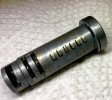Dr.Jeff
True Classic
There is a little rubber seal around the door lock cylinders to help keep crud out (see pic below). I believe someone found a specific O-ring size that fits this perfectly, but now I can't find that reference. I've reviewed all of the door lock threads I could find without any luck. Does anyone know the exact size of the O-ring that will work for this seal?


